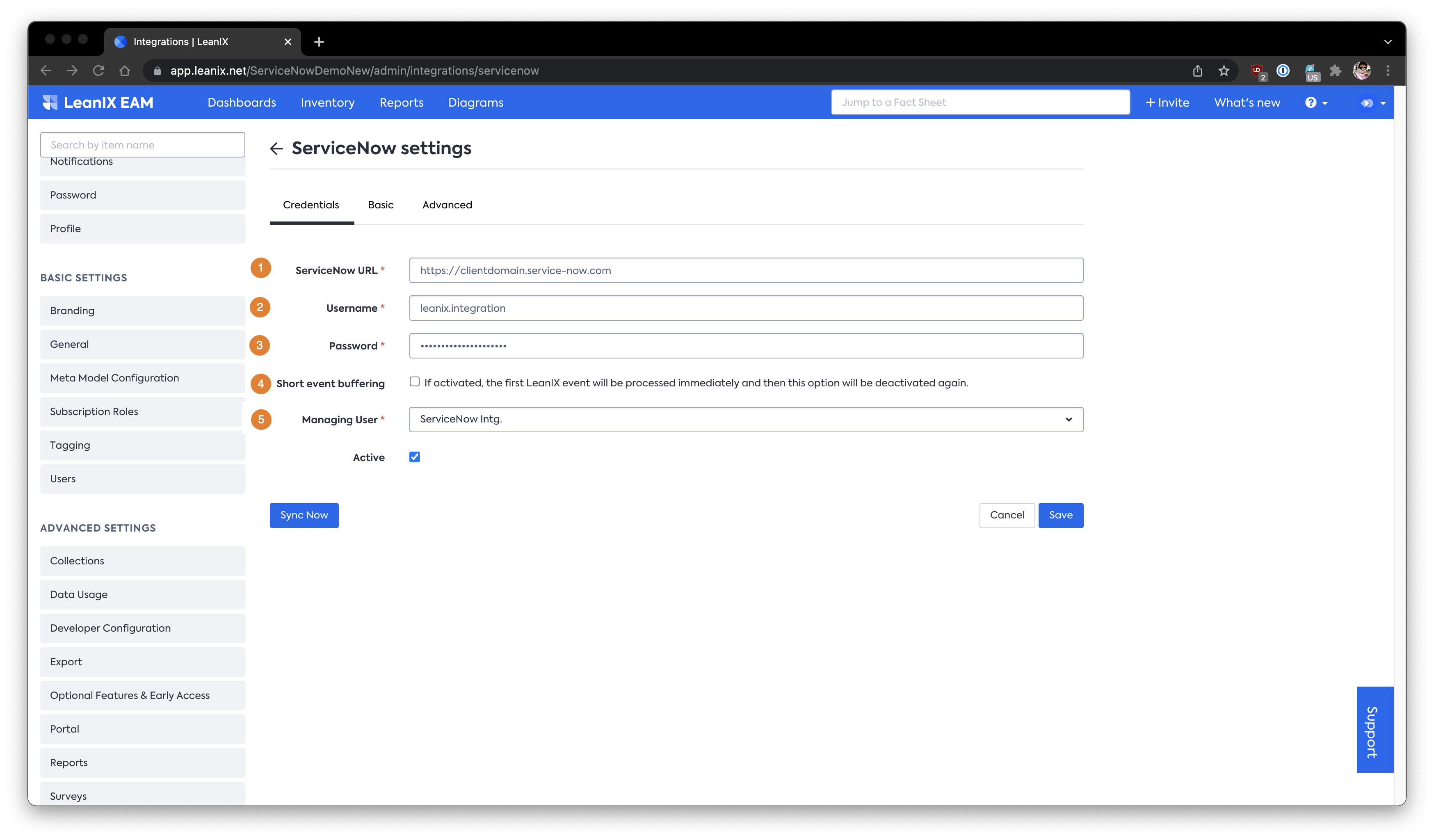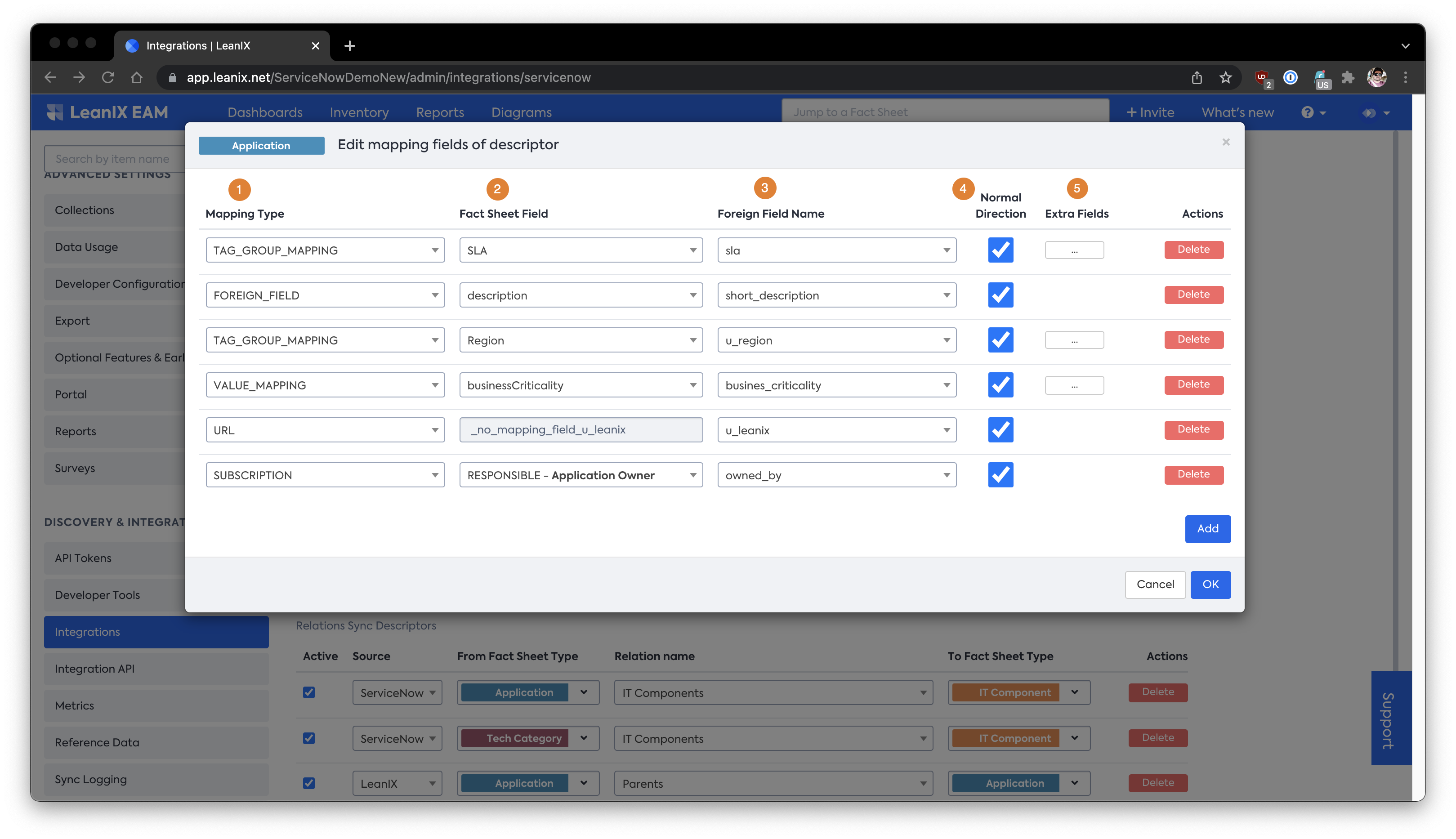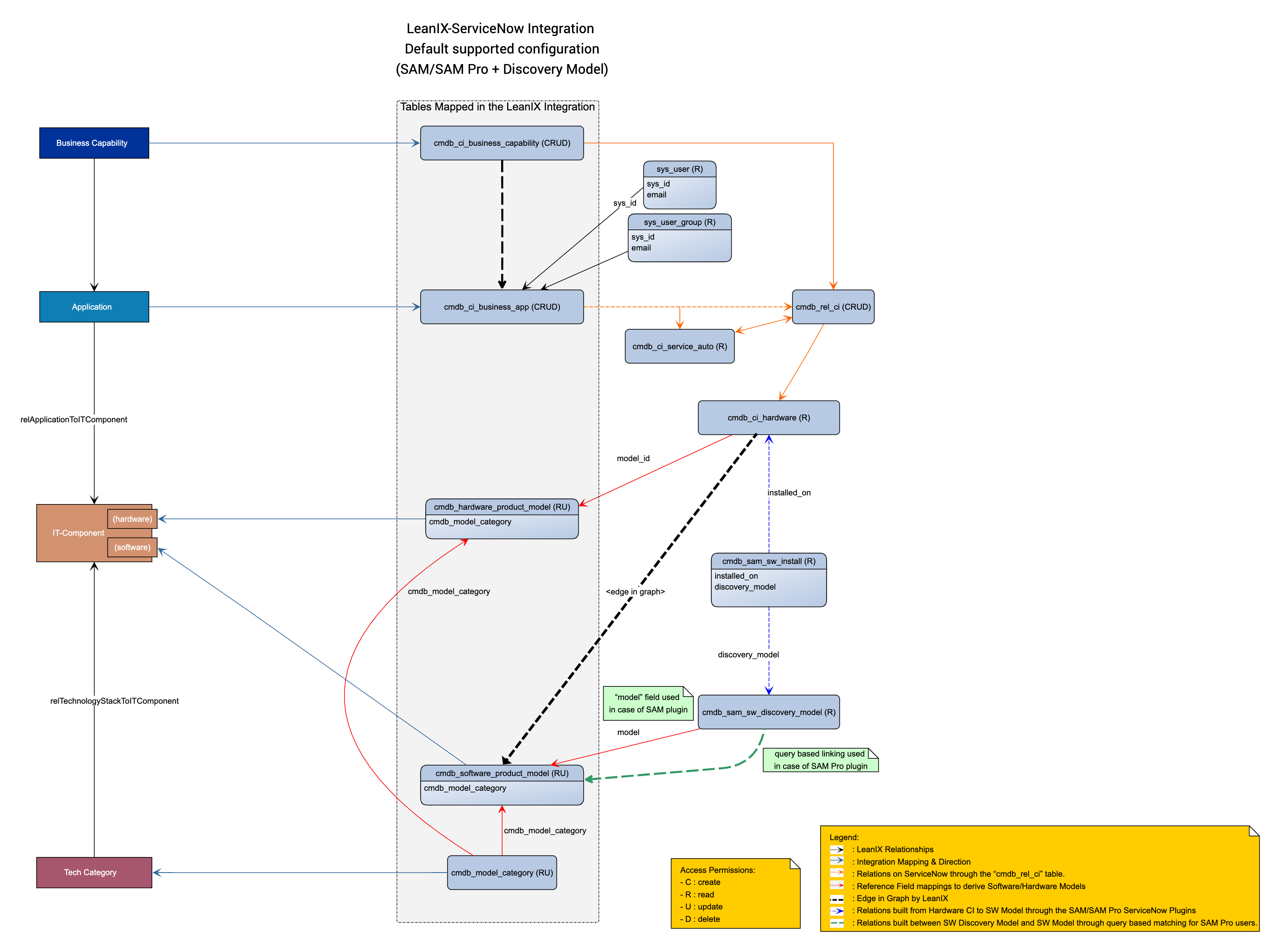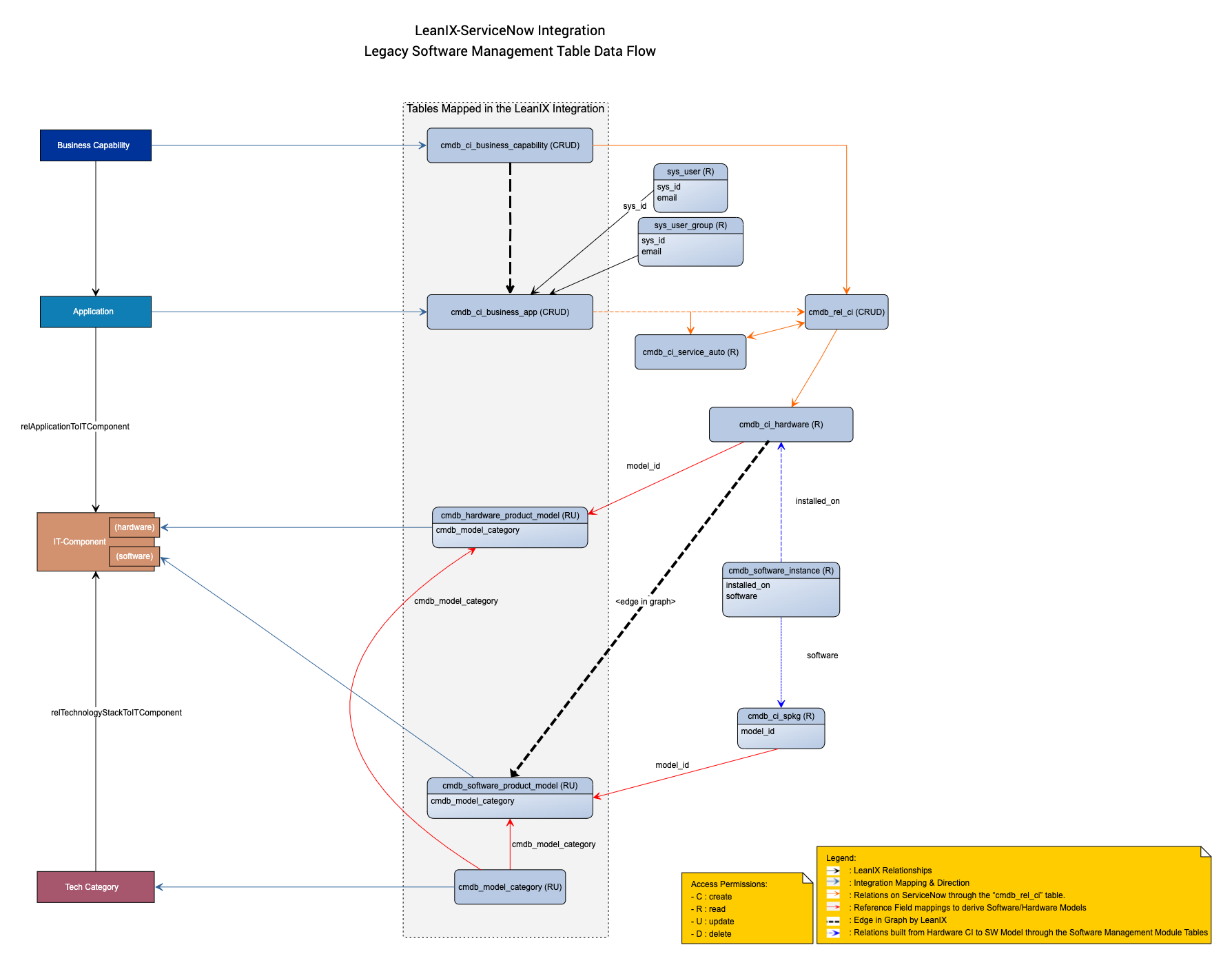ServiceNow Integration
See how LeanIX Integrates with ServiceNow CMDB and learn best practices for implementing it on your workspace.
The LeanIX-ServiceNow Integration is a powerful way to enable transparent flow of data between the two systems. This documentation covers key information to help you understand the Integration more deeply:
- Communication with ServiceNow.
- The core concepts used to integrate.
- The default supported configuration and best practices.
Prerequisites
Before enabling the LeanIX-ServiceNow integration, please make sure you or a colleague/consultant working with you has the fundamental knowledge about ServiceNow CMDB, CSDM, and the ability to do the following within your instance -
- Manage installation and configuration plugins from the ServiceNow store
- Manage users, tables and ACLs in the CMDB
Communication with ServiceNow
The communication between the LeanIX integration running on LeanIX servers and the ServiceNow system depends on the configuration specified in ServiceNow URL.
In case the ServiceNow URL is configured with an https schema, the communication is done through TLS encryption. Furthermore, all client credentials are stored as part of the configuration encrypted using AES-256.
Additionally, the Integration User created can utilize both Basic Auth or oAuth 2.0 for authentication between the two systems.
Communication method when using HTTPS Instance URL
The TLS version and cipher suites used for communication between LeanIX integration and ServiceNow depends on the negotiation to the ServiceNow HTTPS server. In general,
TLS v1.2andTLS_ECDHE_RSA_WITH_AES_128_GCM_SHA256is used for any HTTPS connection to ServiceNow.
The ServiceNow URL mentioned above and the other integration user details are configured in the Integration credentials tab.

Credentials section for connecting to the ServiceNow Instance
| Key | Type |
|---|---|
| 1 | ServiceNow URL section to input url of the instance which is to be connected with the workspace. e.g. https://clientdomain.service-now.com |
| 2 | Username section to input the username of the LeanIX Integration user created within the ServiceNow Instance |
| 3 | Password section to input the password of the Integration user created above. |
| 4 | In case Short event buffering is activated, all changes in LeanIX and SN will be synchronized immediately. This setting is useful for testing or demo purposes, but it will increase the amount of CPU usage and network traffic and should be disabled for production workspaces. |
| 5 | Managing User dropdown allows to utilize a technical user on the LeanIX workspace to run the Integration. This is useful for auditing purposes. |
Core Concepts
For synchronization purposes, every mapping between tables in both systems defines the following:

FS Type / ServiceNow Table mapping keys
| Key | Type |
|---|---|
| 1 | LeanIX Factsheet Type |
| 2 | Name of the table in ServiceNow |
| 3 | Defined source of truth |
| 4 | Whether one should use the 'strict' mode, i.e. whether unsynchronized objects from the non-source table/factsheet type should be deleted right away. This makes sure that both systems always have the same data. |
| 5 | Whether there are any synchronization constraints, e.g. only synchronize applications with a specific lifecycle status or only synchronizing software product models which are actually installed on a server belonging to a managed business application |
Within each mapping type described above, it is possible to configure field level mapping between the two systems.

Field level mapping keys between LeanIX and ServiceNow
| Key | Type |
|---|---|
| 1 | Type of field mapping (Further explained, in the setup in LeanIX documentation) |
| 2 | Name of field in LeanIX (if applicable) |
| 3 | Name of field in ServiceNow (if applicable) |
| 4 | Whether the attribute is to be synced from the defined source of truth or the opposite of the defined source. |
| 5 | How values are being mapped (as is or explicit mapping of one value to another) |
Default Supported Configuration
Required ServiceNow Modules
It is assumed as part of the workflow below that the ServiceNow Instance is using SAM/SAM Pro and the Discovery Service modules within ServiceNow.
CSDM 4.0
As of the last update of this documentation, our suggested default configuration below is in line with CSDM 4.0. Please feel free to reach out to your CSM for any additional or specific questions.
All involved ServiceNow tables and used connections among each table, and the LeanIX Fact Sheet types (and their relations) are shown below.
The flow chart helps illustrate the relations between ServiceNow tables and data flow conditions when constraints are used within the configuration.

Default supported configuration workflow
Custom Configurations
Custom tables, fields and even default CI tables are possible to sync with the Integration. It is recommended however to stay as close to the default supported configuration as possible.
Detailed workflow for the default supported configuration -
| Ownership | Workflow | Additional Context |
|---|---|---|
| LeanIX | Applications are created and maintained in LeanIX. | |
| LeanIX | Business Capabilities are created and maintained in LeanIX | |
| Integration | The integration synchronizes LeanIX Applications to the Business Application table (cmdb_ci_business_app) and the LeanIX Business Capabilities to the Business Capabilities table (cmdb_ci_business_capability) in ServiceNow. | |
| ServiceNow | Business Applications are related to Application Services (cmdb_ci_service_auto) through the Rel CI table (cmdb_rel_ci).Subsequently, the Application Services are related to Hardware CIs (Servers etc.) | LeanIX Integration reads into the Hardware CIs such as Servers which are are connected to Hardware Product Models ( cmdb_hardware_product_model) through the model-id reference field.If you use the Software Asset Management (SAM or SAM-Pro) module of SN, then other tables are used, but the methodology remains the same. |
| Integration | The LeanIX integration will synchronize only the Hardware Product Models (cmdb_hardware_product_model) that have a link to a synchronized Business Application record through the flow above as the IT Component Hardware Record. | |
| ServiceNow | Through Discovery Service and SAM/SAM Pro, Hardware CIs such as Servers are connected to the SAM Software Installed table. ( cmdb_sam_sw_install)Which are then connected to the SAM Software Discovery Model table ( cmdb_sam_sw_discovery_model) through reference field discovery_model. | |
| ServiceNow / Integration | Depending on module, (SAM or SAM Pro) the Integration links the SAM SW Discovery Model record to the Software Product Model record (cmdb_software_product_model) and synchronize that back to LeanIX as an IT Component Software. | For SAM Module - The reference field model is utilized.For SAM Pro - A dynamic query is used instead to form a link. |
| Integration | Using the links described above, the Integration identifies the Business Applications that related to what Software or Hardware Product Model. If a link exists, then the Integration creates an Application to IT Component relationship within LeanIX | |
| Integration | Additionally, Model Categories (cmdb_model_category) are synchronized from ServiceNow to LeanIX. | If a relation exists in SN between a Hardware or Software Product Model and a Model Category, then a relation between the corresponding objects in LeanIX will be created. |
Legacy Configuration
Legacy Software Management Connection
If in case legacy software management module is in use instead of SAM/SAM Pro and Discovery Service, the Integration can be adapted instead to follow the following flow chart instead -

Legacy workflow
Updated about 3 years ago
Continue with the Implementation of the Integration with the Setup in ServiceNow guide!
